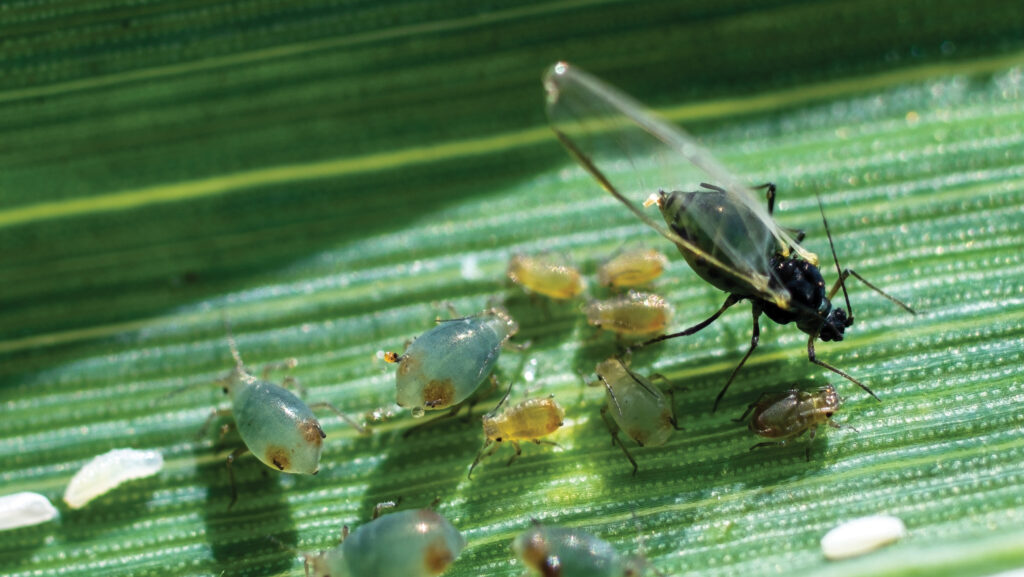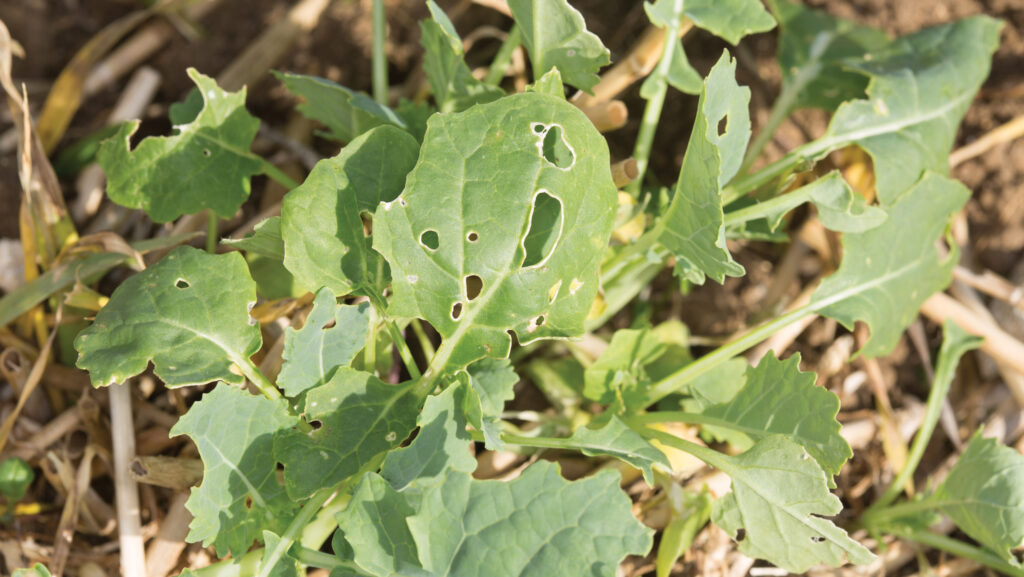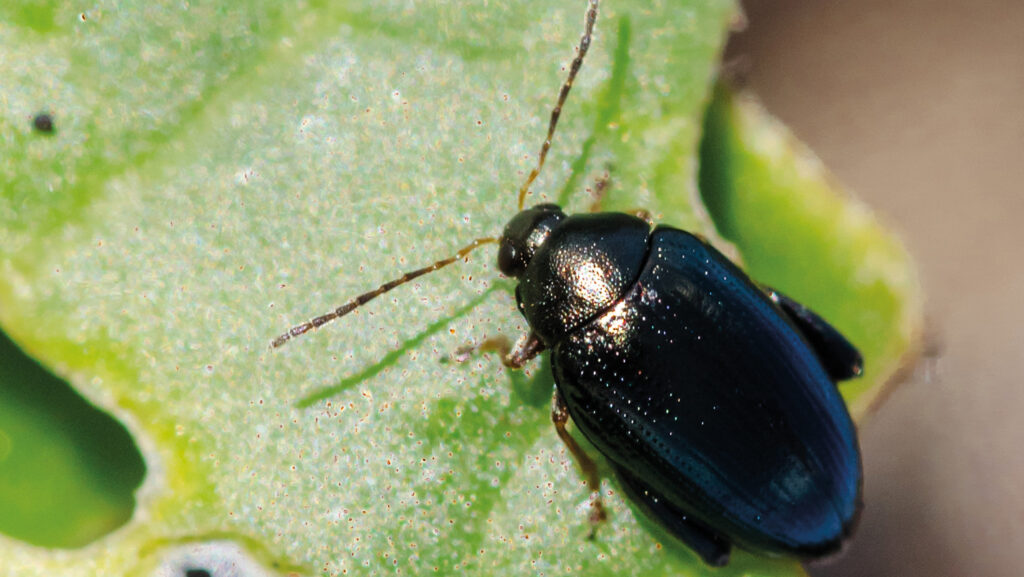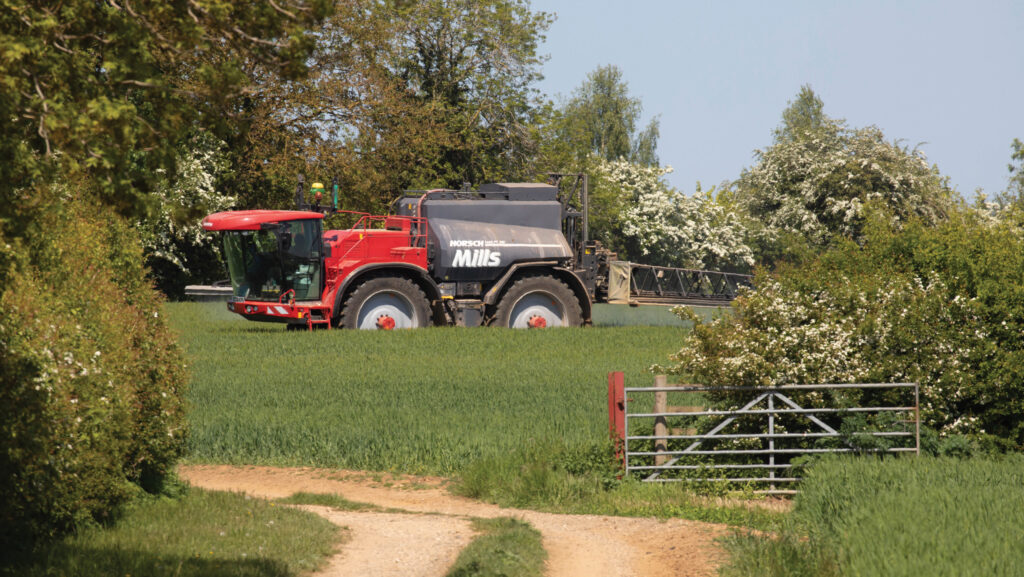How crop nutrition can avoid insect and disease
 Bird cherry-oat aphid © Blackthorn Arable
Bird cherry-oat aphid © Blackthorn Arable Insect and disease attacks do not occur at random. Instead, they show up in specific places in response to specific environmental cues, according to US regen expert John Kempf.
Farmers know that certain field sections may be more vulnerable to pests and disease, but what about that particular area created the conditions for the problem to take hold?
See also: Groundswell: How John Kempf prevents yield declines in regen ag
John founded the agronomy firm Advancing Eco Ag, which specialises in plant nutrition and soil microbial function.
“We all know from our own experiences that disease and insects do not show up indiscriminately,” he says.
“Healthy plants with functioning immune systems can become completely resistant.”
John talks of the foundational disease triangle idea, which states that in order for disease to completely express itself it needs three essential requirements – a susceptible host, a capable pathogen and an optimal environment.
An optimal environment for different organisms includes humidity levels and temperature thresholds, but what exactly makes a crop a susceptible host?
“Historically, we have made the common framework that just the presence of the plant itself means it is inherently susceptible,” he says.
“But that’s a false idea because the immune function of plants can range dramatically.
“We can observe from field practice that some crops are much more susceptible than others.”

Oilseed rape plants attacked by flea beetle © Tim Scrivener
Insect communication
By developing a cropping system that targets a functional microbiome with a balanced crop nutrition programme, it is possible to grow healthy plants with a strong immune system, that are resistant to pest and disease attack.
All insects communicate in the electromagnetic spectrum, where the state of crop health determines whether the plant is identified by the pest as a potential food source.
“When we have healthy plants out in the field that have a functional immune system, they’re photosynthesising well and display a nice dark green colour.
“This appears invisible to insects because the plants have a similar infrared signal to the rest of the background environment.”
However, plants with an imbalanced nutritional profile give off a signal as a potential food source to insects.
“Although an insecticide application may reduce the initial insect population, we have done nothing to solve the actual problem.
“The signal is still there, and if we want to systemically prevent these problems from their very foundation, we have to address the root cause.”
John specifically highlights that he dislikes the word “pest” because it implies a very negative relationship with crops and insects.
“In reality, when you look at this from a broader ecosystem perspective, we realise that insects show up to consume and feed on plants that are not fit for human consumption,” he says.

Cabbage stem flea beetle © Blackthorn Arable
Plant health pyramid
This is where the principles of the plant health pyramid come in to play.
It is a conceptual model, developed by John, that represents the progressive stages of plant health achieved through regenerative agricultural practices.
The four key levels that can be used to achieve optimum plant health are:
1. Complete photosynthesis
Ensuring crops have balanced and adequate access to five key elements – magnesium, nitrogen, iron, manganese, and phosphorus – can help growers achieve greater photosynthetic efficiency.
At this stage, photosynthetic efficiency increases, shifting the carbohydrate profile to more complex carbohydrates.
Plants develop resistance to soil-borne fungal pathogens such as verticillium, fusarium and rhizoctonia, says John.
Nutritional imbalances can otherwise suppress plant health and limit overall photosynthetic efficiency.
As a result of nutrition and microbiome depletion, many plants reach only 15-20% photosynthetic efficiency.
Magnesium, nitrogen and iron provide the foundations of building chlorophyll, which make a plant dark green in appearance.
“The optimal approach is to use a balance of all three. Magnesium forms the centre of the chlorophyll molecule and is surrounded by four nitrogens.
Although iron does not directly form part of the chlorophyll structure, it is required to build it – think of iron as the assembly wrench,” says John.
Manganese plays a key role during the water hydrolysis stage of photosynthesis, while phosphorus is involved with energy storage and transfer.
“I’m not suggesting you need to apply foliar sprays of these five elements to a crop, but to ensure these elements are available to the plant in a balanced approach,” he says.
John says soils are almost universally deficient in iron and manganese due to decades of farming practices that have oxidised soils so much that certain elements are unavailable to plants.
“Cultivations, bare soil exposed to the sun and applications of lime, salt-based fertilisers and glyphosate have all contributed to the oxidisation of soils.
“Together with the degradation of healthy soil microbial populations – which can convert oxidised iron and oxidised manganese into the bioavailable form for crops – it has resulted in high levels of iron and manganese in soil profiles, yet crops are functionally deficient.”

Spraying winter barley © Tim Scrivener
2. Complete protein synthesis
Once plants achieve complete protein synthesis, John states plants become resistant to insects with simple digestive systems, particularly larval and sucking insects such as aphids and flea beetles.
For this to happen, plants require adequate levels of magnesium, sulphur, molybdenum and boron.
“During this stage, plants begin converting all soluble nitrogen compounds into amino acids and complete proteins, so 100% of nitrogen in the plant is converted to a complete protein in every 24-hour photo cycle,” explains John.
Insects with simple digestive systems are incapable of digesting complete proteins.
They do not have the digestive enzymes required to break the final bond that is used to build a complete protein.
Therefore, plants with complete proteins are no longer a viable food source for the insects.
Although John recommends using this as a preventative technique, he says it is possible to use this strategy as a successful treatment for insects causing damage within crops.
“This can be more successful then using insecticide treatments to combat insect infestations and this does not harm beneficial populations,” he says.
3. Increased lipid synthesis
John says that growers can only increase lipid synthesis and reach level three of the plant health pyramid, when plants absorb the majority of their nutrients in the form of microbial metabolites rather than synthetic fertilisers.
“An active and functioning symbiotic relationship between plants and the soil microbiome in the rhizosphere is crucial to provide plant nutrition in the form of microbial metabolites,” he says.
Nutrients absorbed in this form require less energy for cellular conversion then synthetic fertilisers because the metabolites are extremely energy efficient.
This allows the plant to store surplus energy in the form of plant lipids, such as waxes and oils, on the leaf surface, which serve as a protective shield.
Plants, therefore, develop increased resistance to airborne fungal and bacterial pathogens such as downy mildew, powdery mildew, late blight and rust.
The extra energy can also be used in times of an energy crisis.
Synthetic fertilisers, on the other hand, use a significant amount of plant energy which otherwise restricts surplus energy to be stored in lipid form.
4. Increased plant secondary metabolite synthesis
In the final stage of the plant health pyramid, microbes in the plant’s microbiome trigger the plant to increase concentrations of immune compounds, which act as plant protectants against overgrazing and insect and disease attack.
“Many of these compounds have very potent antiviral, antifungal and antibacterial properties.
This mechanism also directly inhibits digestion by insect species,” says John.
Plants require abundant soil microbiome relationships to trigger the immune response to reach this stage of health, which sees plants develop increased resistance to the beetle family, nematodes and viruses.
